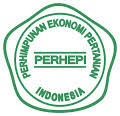Pengaruh Tingkat Penerapan Teknologi Pengendalian Hama Terpadu (Pht) Terhadap Petani Padi Sawah
DOI:
https://doi.org/10.25181/jofsa.v6i2.2321Abstract
This study aimed to analyze the effect of application level of Integrated Pest Management (IPM) technology on Paddy Rice Farmers. The research was carried out in October - November 2021 in Metro City. The sample was 25 farmers selected by purposive technique. Data analysis were descriptive statistics and correlation. Inferential statistical analysis obtained by Spearman Rank correlation test. The results of the analysis showed that the relationship between individual characteristics and the level of application of IPM technology was obtained by sig. 0.000 (99% confidence level). The conclusion was that there was a strong relationship between individual characteristics and the level of application of IPM technology. The results of the analysis of the relationship between the application of the basic principles of IPM with the level of application of IPM technology obtained a sig value. 0.083 (90% confidence level). The conclusion was that there was a sufficient relationship between the application of the basic principles of IPM and the level of application of IPM technology.Downloads
References
Arikunto, S. (2022). Prosedur Penelitian Suatu Pendekatan Praktik. PT. Rineka Cipta.
Dani, A., Rusman, Y., & Noormansyah, Z. (2016). Dampak Sekolah Lapang Pengendalian Hama Terpadu (SLPHT) Terhadap Tingkat Penerapan Teknologi Pengendalian Hama Terpadu (PHT) pada Usahatani Padi Sawah (Oryza sativa L.) (Studi Kasus Pada Kelompok Tani Kutawaringin Desa Cinyasag Kecamatan Panawangan Kabupa. Jurnal Ilmiah Mahasiswa Agroinfo Galuh, 2(3), 159–166. https://doi.org/http://dx.doi.org/10.25157/jimag.v2i3.272
Defika, F., Efendi, I., & Rangga, K. K. (2021). Peranan Penyuluh Pertanian dalam Meningkatkan Kinerja Kelembagaan Kelompok Tani Padi Sawah Penerima Bantuan Rice Milling Unit (RMU) di Kota Bandar Lampung. Journal of Food System and Agribusiness, 5(1), 84–92. https://doi.org/10.25181/jofsa.v5i1.1666
Effendy, L., Billah, M. T., & Darmawan, D. (2020). Perilaku Petani Dalam Pengendalian Hama Terpada Pada Budidaya Padi di Kecamatan Cikedung. Jurna Inovasi Penelitian, 1(3), 287–301.
Koampa, M. V., Olfie, B., Sendow, M., & Moniaga, V. R. (2015). Partisipasi Kelompok Tani Dalam Kegiatan Penyuluhan Pertanian Di Desa Kanonang Lima Kecamatan Kawangkoan Barat. ASE, 11(3A), 19–32.
Listiana, I. (2017). Kapasitas Petani Dalam Penerapan Teknologi Pengendalian Hama Terpadu (PHT) Padi Sawah di Kelurahan Situgede Kota Bogor. Agrica Ekstensia, 11(1), 1–52.
Martono, E. (2006). SLPHT Sebagai Lembaga Pemberdayaan Petani. Jurnal Ilmu-Ilmu Pertanian, 2(1), 1–5.
Ramadan, Y. M., Chdiyat, & Saridewi, T. R. (2020). Kemandirian Petani Dalam Penerapan Pengendalian. Jambura Agribusiness Journal, 2(1), 1–13.
Saptana, S., Panaji, T., Tarigan, H., & Setianto, A. (2005). Analisis Kelembagaan Pengendalian Hama Terpadu Mendukung Agribisnis Kopi Rakyat Dalam Rangka Otonomi Daerah. SOCA: Jurnal Sosial Ekonomi Pertanian, 32–34.
Sari, N., Fatchiya, A., & Tjitropranoto, P. (2016). Tingkat Penerapan Pengendalian Hama Terpadu (PHT) Sayuran di Kenagarian Koto Tinggi, Kabupaten Agam, Sumatera Barat. Jurnal Penyuluhan, 12(1), 15–30. https://doi.org/10.25015/penyuluhan.v12i1.11316
Satyani, T., Arfan, & Sayani. (2019). Kabupaten Donggala Evaluation of the Use of Pesticides in Red Onion Farmers in Wombo Mpanau Village , Tanantovea Sub District. Jurnal Agrotech, 9(1), 26–32.
Suanda, I. W. (2015). Pelestarian keanekaragaman hayati tumbuhan sebagai bahan pestisida ramah lingkungan. Prosiding Seminar Nasional Prodi Biologi F. MIPA UNHI, 220–223.
Suherlan Effendi; Baehaki. (2009). Tanaman Padi Dalam Perspektif Praktek Pertanian Yang Baik ( Good Agricultural. Pengembangan Inovasi Pertanian, 1(2), 65–78.
Wijoyo, S., Ma’ruf, A., & Aisyah, R. H. S. (2021). Pemberdayaan Masyarakat Dalam Budi Daya Jamur Tiram Di Kab Ngawi. JMM - Jurnal Masyarakat Merdeka, 3(2). https://doi.org/10.51213/jmm.v3i2.58
Downloads
Published
How to Cite
Issue
Section
License
Copyright (c) 2023 Journal of Food System and Agribusiness

This work is licensed under a Creative Commons Attribution-NonCommercial 4.0 International License.
With the receipt of the article by the Journal of Food System and Agribusiness Editorial Board and the decision to be published, then the copyright regarding the article will be diverted to the Journal of Food System and Agribusiness.
Politeknik Negeri Lampung as the publisher of the Journal of Food System and Agribusiness holds the copyright regarding all the published articles in this journal.
Politeknik Negeri Lampung has the right to multiply and distribute the article and every author is not allowed to publish the same article that was published in this journal.
The manuscript authenticity and copyright statement submission can be downloaded ON THIS FORM. Fill out the form and submit as a supplementary file.
All publications by Journal of Food System and Agribusiness is licensed under a Creative Commons Attribution Non-Commercial 4.0 International License.
























